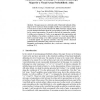Free Online Productivity Tools
i2Speak
i2Symbol
i2OCR
iTex2Img
iWeb2Print
iWeb2Shot
i2Type
iPdf2Split
iPdf2Merge
i2Bopomofo
i2Arabic
i2Style
i2Image
i2PDF
iLatex2Rtf
Sci2ools
108
Voted
MICCAI
2003
Springer
2003
Springer
Statistical Shape Modeling of Unfolded Retinotopic Maps for a Visual Areas Probabilistic Atlas
Abstract. This paper proposes a statistical model of functional landmarks delimiting low level visual areas which are highly variable across individuals. Low level visual areas are first precisely delineated by fMRI retinotopic mapping which provides detailed information about the correspondence between the visual field and its cortical representation. The model is then built by learning the variability within a given training set. It relies on an appropriate data representation and on the definition of an intrinsic coordinate system to a visual map enabling to build a consistent training set on which a principal components analysis (PCA) is eventually applied. Our approach constitutes a first step toward a functional landmark-based probabilistic atlas of low level visual areas.
| Added | 15 Nov 2009 |
| Updated | 15 Nov 2009 |
| Type | Conference |
| Year | 2003 |
| Where | MICCAI |
| Authors | Isabelle Corouge, Michel Dojat, Christian Barillot |
Comments (0)

